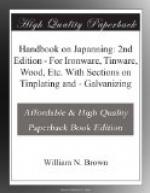MODERN METHODS OF JAPANNING AND ENAMELLING WITH NATURAL JAPANESE LACQUER.
Urushiol, the principal constituent of Japanese lacquer, does not according to the Japanese investigator, Kisaburo Miryama, dry by itself at ordinary temperatures, but can be dried with ease at a temperature above 96 deg. C. In the same way, lacquer that has been heated to a temperature above 70 deg. C. and has entirely lost its drying quality can be easily dried at a high temperature. In this method of japanning the higher the temperature is, the more rapidly does the drying take place; for instance, a thin layer of urushiol, or lacquer, hardens within 5 hours at 100 deg. C., within 30 minutes at 150 deg. C., and within 10 minutes at 180 deg. C. Japanning at a high temperature with natural lacquer does not require the presence of the enzymic nitrogenous matter in the lacquer, and gives a transparent coating which is quite hard and resistant to chemical and mechanical action; in these respects it is distinguished from that dried at an ordinary temperature. During the drying, oxygen is absorbed from the atmosphere and at the same time a partial decomposition takes place.
This method of japanning has its application in lacquering metal work, glass, porcelain, earthenware, canvas, papier-mache, etc.; because the drying is affected in a short time, and the coating thus obtained is much more durable than the same obtained by the ordinary method.
For practical purposes it is better to thin the lacquer with turpentine oil or other solvent in order to facilitate the lacquering and lessen the drying time of the lacquer. Since the lacquer-coating turns brown at a high temperature, lacquers of a light colour should be dried at 120 deg. to 150 deg. C.; and even those of a deep colour must not be heated above 180 deg. C. Most pigments are blackened by lacquer; therefore the varieties of coloured lacquers are very limited.
FOOTNOTES:
[1] A question has been raised concerning the safety of Perkins’ apparatus, not merely as relates to the danger of explosion, but also respecting that of high temperature; and it has been asserted that the water may be so highly heated in the tubes as to endanger the charring and even inflammation of paper, wood, and other substances in their contact or vicinity: such no doubt might be the case in an apparatus expressly intended for such purposes, but in the apparatus as constructed by Perkins, with adequate dampers and safety valves, and used with common care, no such result can ensue. Paper bound round an iron tube is not affected till the temperature exceeds 400 deg.; from 420 deg. to 444 deg. it becomes brown or slightly singed; sulphur does not inflame below 540 deg..
SECTION V.
COLOURS FOR POLISHED BRASS—MISCELLANEOUS.




